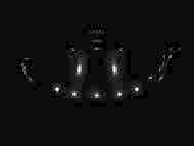Graphics Reference
In-Depth Information
Figure 8.20
Differences between the BRDFs in the linear span of the PCA basis vectors and the Gaus-
sian basis representation. A measured BRDF is shown at the left. In the center is an im-
plausible BRDF from a nearby “point” in the linear span. The right image is a BRDF at a
comparably close point in the Gaussian subspace; the BRDF is different, but still physically
plausible. (From [Matusik et al. 03]
c
2003 ACM, Inc. Included here by permission.)
veloped a method for searching the subspace for new traits in a way that maintains
particular traits already specified by the user.
Although the image-based BRDF approach presented in the paper was more
of a proof of concept than a fully developed BRDF generation system, it gained
attention as an entirely new way of modeling BRDFs. In addition, while lin-
ear approximations had been used to approximate BRDFs for years, this was the
first attempt at a representation of realizable BRDF as a nonlinear subspace of a
general BRDF space. The work inspired research into other approaches that ap-
proximate reflection by mathematically analyzing sets of measured data. Much
of this was concurrent with research into BTF rendering and relighting, which
is described in the next chapter. Image-based BRDF models will likely play an
important role not only in reconstructing real world surface reflectance, but also
in improving analytical BRDF models.
In fact, the work has already provided insight into the effectiveness of existing
analytical BRDF models. The authors' collection of measured BRDF data con-
tains reflectances for a wide range of surfaces. Addy Ngan, Fredo Durand, and
Wojciech Matusik used this data to test the effectiveness of many existing BRDF
models in fitting real data. They presented the results in a SIGGRAPH technical
sketch entitled “Experimental Validation of Analytical BRDF Models” and also
in a technical paper published in the Eurographics Symposium on Rendering in
2005.
Existing BRDF models can be split into two basis types: those that use the
specular deviation angle
between the view direction and the specular direction,
and those that use the half-angle
α
θ
h
between the half-vector and the surface nor-
mal. The Phong model, general cosine lobe models, and the Lafortune model
use the former; Blinn's model, Ward's model, the Ashikhmin-Shirley model, and
most of the microfacet models use the latter. The conclusion was that models










